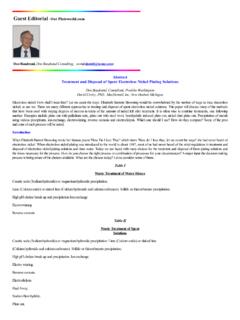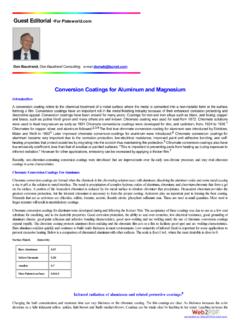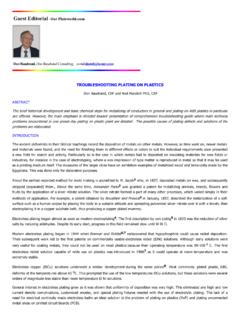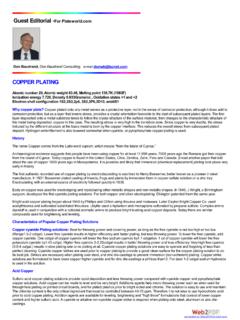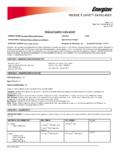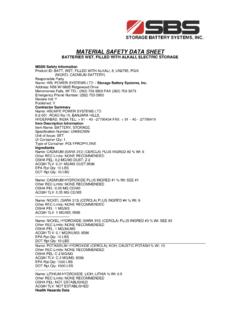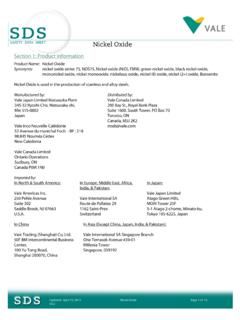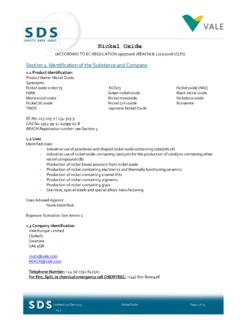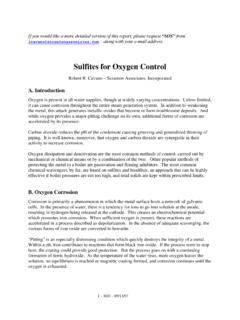Transcription of From Nickel Plating Solutions Do’s & Don’ts of …
1 Guest Editorial -For Don Baudrand, Don Baudrand Consulting, Do s & Don ts of Removing Contaminants From Nickel Plating SolutionsThe contaminants, also called impurities, that can cause defects in Nickel Plating Solutions require removal to correct defects and improve theoverall quality of the Nickel deposit. Some removal processes are easy to do, others require considerable time and effort and knowledge. I haveparticipated in nearly all of these procedures. I know first hand the amount of work and the difficulties that can arise. The rewards are goodnickel Plating that meet or exceeds requirements and g/L can cause fine roughness ("star dusting"), brittle deposits and possible cracking. Removal is by the high : Pump the Plating solution into a clean storage tank.
2 Raise the pH using 1. Nickel carbonate in a slurry. Do not put Nickel carbonatepowder directly into the tank 2-7 lbs ( g/L) of Nickel carbonate per 100 gallons of Plating solution. 2. A better (in my opinion) method is topack a filter with Nickel oxide circulate the Nickel bath through the filter until the pH reaches It takes about lbs of Nickel oxide per100 gallons of solution. Filter back into a clean Plating tank and adjust the pH to arsenic and cadmium- 1000 ppm is : Using a corrugated dummy cathode, plate at 3-5 amps/sq ft. ( A/dmsq A/dmsq) for several Causes tensile stress and lowered ductility starting about 2500 ppmRemoval: High pH treat as in aluminum removal above, but at 160F (71C). Stir for 1-3 the presence of calcium is often indicated by long needle like crystals clinging to the anode bags.
3 Calcium sulfate is only slightlysoluble, so that at higher temperatures cadmium tends to salt out forming fine crystals resulting in "star dusting" or fine roughness. If DI water isused for tank make up and rinse water prior to the Nickel tank, calcium is much less likely to be presentRemoval: In a storage tank, Raise the temperature to 160F (71C) Calcium has inverse solubility. That is it is less soluble at highertemperatures than at lower temperatures. For more complete removal, add g/L sodium fluoride to form insoluble calcium fluoride. Stir, andthen filter back to the Plating tank maintaining the high temperature through out the little as 3 ppm of hexavalent chrome and 8 ppm of trivalent chromium can produce defects. Many platers wait until the chromiumid much higher or where defects are no longer tolerated.
4 Removal is : Transfer the Plating solution to a clean storage tank. Lower the pH by adding dilute sulfuric acid to pH Add slurry of 4 oz/gal (30g/L) sodium bisulfite. Stir well for at least 1 hour. Then add slowly and carefully 5 gal. Per 1000 gal. ( ) of 30% hydrogen peroxide. Stir forat least 2 hours. Then add slurry of Nickel carbonate. Or, Add Nickel oxide or Nickel carbonate (see above in Treating for aluminum) to pH causes precipitation of now insoluble trivalent chromium as chromium hydroxide . Add 4-6 lbs of activated carbon; stir vigorously for aboutan hour or more. Add filter aid (2 lbs/100 gal.) Settle for several hours then filter back into a clean Plating tank. Add addition agents adjust finalpH and temperature and start hardens the deposit and adds to the tensile stress.
5 I do not know a method to remove cobalt. Any suggestions?Copper- 50 ppm or more causes a dark low CD area. Copper is removed by Plating at 5 amps/sq ft ( A/sqdm). If a corrugated dummycathode is used, copper and other metallic impurities will be over 300 ppm can cause rough deposits, tensile stress, and loss of : A high pH treatment will remove Iron. Add hydrogen peroxide ( by vol.) then raise the pH (as above) to 5. Stir for l hour ormore. Add filter aid. Let it settle and filter back into a clean Plating tank. Heat the Plating solution to 160F (71C) for 2-3 hours to drive off anyresidual hydrogen peroxide. Adjust the pH to if the operating pH is maintained at or higher, iron would not dissolve easily in a Watts type Plating solution. Using continuous filtration,converted by hydroxide , if any, will be picked up on the filter.
6 A sulfamate Nickel solution will dissolve iron, but it will precipitate as iron hydroxide at pH 4or in a sulfamate Nickel , lead at above 2 ppm can cause dark low CD areas. Lead sulfate is not soluble in a Watts solution, but can cause"star dusting" as it precipitates from the solution. Continuous filtration is : low current density dummy Plating at. Lead plates out at 2 amps/sq ft. ( A/dmsq)Magnesium and Manganese- are tolerated up to about 2 g/L with no apparent problem. Manganese reacts with sulfur in the deposit when thedeposit is heated, such as welding, etc. to prevent sulfur migration to the heated that can result in stress cracking of the these reduce cathode efficiency and decreases leveling in bright nickels. I don t know how to remove nitrates or nitrites. Cansomeone provide a method?
7 Sometimes the addition of sulfamic acid relives the impurities can cause numerous : Some organic contaminants can be removed by carbon packed in a filter or special carbon cartridges. Many other organiccontaminants are not so easily removed. These call for more drastic means of removal. Two methods are presented. Both remove brightenersfrom the Nickel peroxide oxidizing method:In a clean storage tank holding the Nickel solution to be treated, add 3 gallons of 30% hydrogen peroxide per 1000 gallons of Plating for 30 minutes to 2 hours. Heat the solution to 155F (68C). Add 2 4 lbs per 100 gallons of activated carbon per 100 gallons of nickelsolution. Stir for about 3 hours. Stir in about 2 lbs/100 gallons of filter aid. Stir then turn off the agitation and let settle 4 to 8 hours, longer ifnecessary but not overnight.
8 Carbon will give up some of the entrapped organics on long standing. Maintain the high temperature to drive offexcess hydrogen peroxide. Filter back to the clean Plating tank. Note that this procedure will also remove chromium, iron, and aluminum if thepH is raised to permanganate method:Potassium permanganate can be used to oxidize the organic materials. Permanganate is a much stronger oxidizing agent than hydrogenperoxide. It will remove the more stubborn organic : raise the temperature to 140-150F (60-66C). Raise the pH to using Nickel carbonate slurry or Nickel oxide in a filter. It will takeabout 2-7 lbs ( g/L) of Nickel carbonate or Nickel oxide lbs ( g/L) per 100 gallons. These materials can be added to a filterand recirculating the Nickel solution through the filter until the desired pH is reached.
9 Dissolve the potassium permanganate in hot water 2-4lbs/100 gallons. ( kg). Add with stirring. Stir for at least 30 minutes, and then add the activated carbon as above. Add filter aid and letsettle for about 8 hours, not over night if it can be avoided. Filter into the cleaned Plating tank. This procedure will remove all brighteners in abright Nickel solution. This procedure will not remove chromium unless hydrogen peroxide is added after the above treatment sufficient toreduce all the excess sodiumbisulfiteFor removal of some organic contaminants a high pH carbon treatment may suffice without using hydrogen peroxide or may be removed by dummy Plating ("electrolytic purification") at 2-4 ASF ( Amps/dmsq.)Do sAnalyze the Nickel Plating Solutions for impurities regularly to prevent all items that falloff racks into the racks, checking for cracks or improperly coated rack tips that could entrap preparation step adequate filtration equipment for continues filtration, and/or carbon filtration, and for treatment.
10 It takes a large filter area to tsShort cut the procedures for scrap parts as the dummy cathode. Control of current density is carbon packed filters for carbon powder added directly to the carbon granules instead of powdered activated carbon. There is not sufficient carbon area to do an adequate job. Granulated carbon isoften used for recirculating during the Plating cycle and for down time to continuously remove small quantities of by
